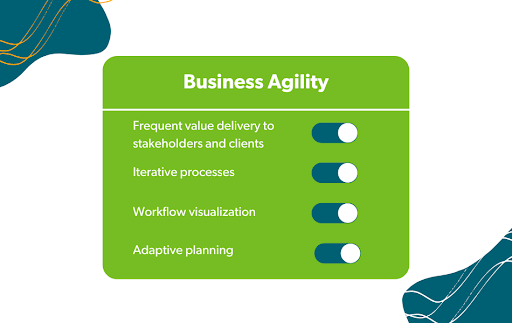There’s a reason Agile practices have expanded so far outside of their humble software development origins: they get results. Specific functions like engineering and marketing are already Agile or are planning to transition. Teams, functions, and entire organizations are undertaking Agile transformations to unlock the increased visibility, quality, alignment, and value delivery this approach has to offer.
But all of that begins with some core elements, especially properly executed Agile management. So let’s understand what business agility and Agile management are before delving into how those management techniques enable you to unlock the full potential of business agility.
Start with Business Agility Fundamentals
Understanding any application of Agile begins with understanding Agile principles and practices based on the original Agile manifesto. While it was originally designed for software development, it has since been adapted for use across the entire business.
In adopting that original manifesto, business agility emphasizes frequent value delivery to stakeholders and clients via iterative processes, extensive workflow visualization, and adaptive planning. That’s a lot, so let’s break it all down.

Value is what the customer is willing to pay you for. Delivering that value to your stakeholders should be your main focus, whether that’s management or a customer. The aim is to avoid all the work done simply because it’s always been done or someone asked for it. By focusing only on doing what generates value, organizations become far more effective at delivering it.
Then there are the iterative processes. These are about breaking work up into shorter cycles which create natural pauses for reflection on what’s working, what can be improved, etc. So instead of letting a project run for 6 months before anyone asks whether it’s delivering value or being managed the best way, it’s broken up into shorter segments so these questions can be asked throughout the process.
Visualization is just as critical. Individual teams and even entire organizations can use tools like a Kanban board to visualize their work. This ensures everyone can see where blockages are, who might be working on too much at once, etc. It also puts context and resources in one place, empowering individuals to start on the next thing instead of waiting to be told what they should do next.
Lastly, there’s adaptive planning. This ties back to the iterative processes. Instead of relying only on something like quarterly planning, you plan work for those smaller iterative cycles. This enables teams and organizations to pivot and adapt far faster. So when circumstances change, you change to meet them rather than doing things that don’t make sense anymore just because that’s what you previously planned.
Taken together, all of these factors explain why business agility is so powerful. It pushes organizations to deliver more value more quickly while adapting and learning all the time. But what then is Agile management and how does it fit into business agility?
What Is Agile Management?
Also commonly referred to as Agile project management, Agile management applies the principles we mentioned above toward managing teams and projects. Often an Agile manager will be responsible for helping ensure their team is effectively using those principles to achieve their goals. However, when the team uses Scrum (the most popular Agile approach in tech), this is also supported by a Scrum master.
Doing that requires a good understanding of Agile principles because Agile isn’t just one thing. Any application of Agile will require modifications based on your conditions. Trying to make adjustments to an Agile framework without understanding the principles behind it is a very fast way to arrive at a harmful kind of “fake Agile.”
In other words, Agile management isn’t just about an individual applying Agile principles and practices to their own work process, it’s about leading an Agile team towards best results with their own workflow. This is why Agile training is so important for managers and team members alike. However, despite this importance, Agile managers often make serious mistakes when it comes to Agile education.
What Makes Agile Management so Important?
Agile managers are the lynchpin in any Agile organization. You can have all the Agile-trained team members you want, but without managers to coordinate and ensure teams are aligned with leadership, things can go off the rails quickly.

But Agile organizations are supposed to be less hierarchical, so how does this kind of vertical coordination work in an Agile environment without violating the Agile goal of a flat organizational structure?
In practice, this works by avoiding the non-Agile situation where all decisions are made at the top and filtered down. Instead, there should be an interchange between teams working on the ground and senior leaders. The C-suite will share its strategic goals for the company while Agile teams are best placed to make decisions about what will bring the most value for stakeholders based on their capabilities.
Agile managers play a key role as an intermediary between those two groups, ensuring that strategic objectives are accounted for while simultaneously making sure individual teams are best serving stakeholders.
If an organization moves too far in one or the other direction, either working towards strategic goals that don’t make sense on the ground or doing what makes sense for individual teams without any thought to the bigger picture, the results can be disastrous.
Is Agile Management Worth Investing in?
In case the answer isn’t clear by now, yes! Agile management is important when you’re getting your very first Agile team up and running, leading that transition and working to adapt Agile to specific circumstances. But that management only becomes more important as you move towards business agility, bringing Agile into more and more functions within the organization.
So whether you’re looking at Agile for the first time or thinking about expanding it within your organization, investing in high-quality Agile management is critical. You want to ensure Agile managers are both familiar with the foundational Agile principles and, ideally, have practiced applying those principles in real-world situations.
That’s why getting the most out of Agile management requires an ongoing commitment to quality Agile education and coaching.
Taking Your First Step Towards Effective Agile Management
While the exact steps will depend on where your Agile managers are in their education, an excellent foundation is our Introduction to Business Agility Course. It’s designed to help managers see the big picture and understand how to balance the demands of leadership and individual team members in an effective and Agile way.